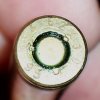Backstory:
I purchased a case of this 7.62x39 at a gun show. It was advertised as Portuguese, non-corrosive. Upon doing some initial homework I thought I had my bases covered. It wasn't until later that I found some other info that put doubt in my head.
I have searched other gun boards as well as this one. It would be nice to know the origin but my real goal is to determine for certain whether it is corrosive or non-corrosive. Please don't just say, "Clean your gun as if it were corrosive and just shoot it." I will do that either way, I just want to establish if this dealer I purchased from is on the up-and-up.
Description:
The ammo is brass cased and the headstamp, as seen in attached photo, has 7.62x39 on top and 95 on bottom. There are also three equidistant square crimp marks around primer. The stamping is somewhat faint especially on the 7.62x39. The top of the 7 is barely visible even to the naked eye, so it's not just the photo.
Questions:
1. Where could it be from based on the headstamp/appearance?
2. Is it corrosive or non-corrosive?
3. Are there any tests one can conduct to determine corrosive status if appearance alone will not allow for clear determination.
I purchased a case of this 7.62x39 at a gun show. It was advertised as Portuguese, non-corrosive. Upon doing some initial homework I thought I had my bases covered. It wasn't until later that I found some other info that put doubt in my head.
I have searched other gun boards as well as this one. It would be nice to know the origin but my real goal is to determine for certain whether it is corrosive or non-corrosive. Please don't just say, "Clean your gun as if it were corrosive and just shoot it." I will do that either way, I just want to establish if this dealer I purchased from is on the up-and-up.
Description:
The ammo is brass cased and the headstamp, as seen in attached photo, has 7.62x39 on top and 95 on bottom. There are also three equidistant square crimp marks around primer. The stamping is somewhat faint especially on the 7.62x39. The top of the 7 is barely visible even to the naked eye, so it's not just the photo.
Questions:
1. Where could it be from based on the headstamp/appearance?
2. Is it corrosive or non-corrosive?
3. Are there any tests one can conduct to determine corrosive status if appearance alone will not allow for clear determination.


